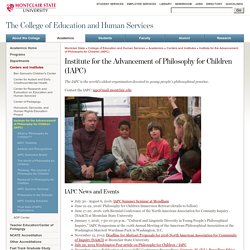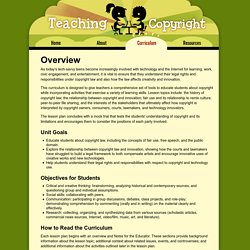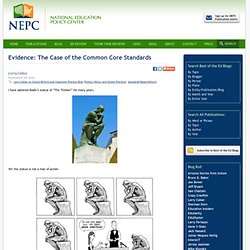

Centerforcreativity.netcenterforcreativity.net. Common Core / Homepage. Institute for the Advancement of Philosophy for Children. The IAPC is the world’s oldest organization devoted to young people’s philosophical practice.

Contact the IAPC: iapc@mail.montclair.edu IAPC News and Events Mission Statement The Institute for the Advancement of Philosophy for Children pursues a three-fold mission: Educational Programming Dissemination and Professional Affiliation Research The primary constituency the IAPC aims to serve is schoolchildren—from pre-schoolers to highschoolers and from schools close to the Institute to schools in the 40-odd nations with active Philosophy for Children centers. New Tech Network. UbD. Curriculum: Understanding YouTube & Digital Citizenship – Google in Education. Overview We have devised an interactive curriculum aimed to support teachers of secondary students (approximately ages 13-17).

The curriculum helps educate students on topics like: YouTube’s policies How to report content on YouTube How to protect their privacy online How to be responsible YouTube community members How to be responsible digital citizens We hope that students and educators gain useful skills and a holistic understanding about responsible digital citizenship, not only on YouTube, but in all online activity. Lessons in English Below is a list of lessons, and the recommended flow for delivery. Or you can download the Full Teacher's Guide or the Full Set of Slides in PDF. Lessons in Additional Languages Below is a list of lessons and resources in additional languages beyond English: Learn more To learn more visit the Classroom videos page of this website, where you can find links to information on:
Teaching Copyright. As today's tech-savvy teens become increasingly involved with technology and the Internet for learning, work, civic engagement, and entertainment, it is vital to ensure that they understand their legal rights and responsibilities under copyright law and also how the law affects creativity and innovation.

This curriculum is designed to give teachers a comprehensive set of tools to educate students about copyright while incorporating activities that exercise a variety of learning skills. Lesson topics include: the history of copyright law; the relationship between copyright and innovation; fair use and its relationship to remix culture; peer-to-peer file sharing; and the interests of the stakeholders that ultimately affect how copyright is interpreted by copyright owners, consumers, courts, lawmakers, and technology innovators. Unit Goals Educate students about copyright law, including the concepts of fair use, free speech, and the public domain. Evidence: The Case of the Common Core Standards. I have admired Rodin’s statue of “The Thinker” for many years.

Yet the statue is not a man of action. Too much thinking, too little action is a recipe for fecklessness. Yet too much action, too little thought are ingredients for a potential disaster.* And this is where the Common Core standards enter the picture. Exactly how much evidence did policymakers have to justify the crafting and adoption of national standards? There have been two major justifications for Common Core standards: (1) raising academic standards across U.S. schools will grow the economy and make the nation globally competitive; (2) higher standards will improve students’ academic achievement. 1. Answer: None. See here and here. 2. See here, here and even here. So how can a public policy that has heavy consequences for students, teachers, and public schools have an appalling lack of evidence? The answer is in what top decision-makers consider as evidence when they determine policy.
As Children’s Freedom Has Declined, So Has Their Creativity. If anything makes Americans stand tall internationally it is creativity .

“American ingenuity” is admired everywhere. We are not the richest country (at least not as measured by smallest percentage in poverty), nor the healthiest (far from it), nor the country whose kids score highest on standardized tests (despite our politicians’ misguided intentions to get us there), but we are the most inventive country. We are the great innovators, specialists in figuring out new ways of doing things and new things to do. Perhaps this derives from our frontier beginnings, or from our unique form of democracy with its emphasis on individual freedom and respect for nonconformity. In the business world as well as in academia and the arts and elsewhere, creativity is our number one asset. It is sobering, therefore, to read Kyung Hee Kim’s recent research report documenting a continuous decline in creativity among American schoolchildren over the last two or three decades.[2] Well, surprise, surprise.